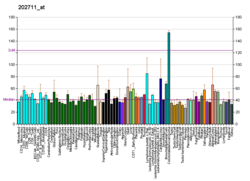Ephrin B1
Appearance
(Redirected from EFNB1)
Ephrin B1 is a protein that in humans is encoded by the EFNB1 gene.[5][6] It is a member of the ephrin family. The encoded protein is a type I membrane protein and a ligand of Eph-related receptor tyrosine kinases. It may play a role in cell adhesion and function in the development or maintenance of the nervous system.[7]
Clinical significance
[edit]Mutations in this protein are responsible for most cases of craniofrontonasal syndrome.[8][9][10]
Interactions
[edit]EFNB1 has been shown to interact with SDCBP.[11]
References
[edit]- ^ a b c GRCh38: Ensembl release 89: ENSG00000090776 – Ensembl, May 2017
- ^ a b c GRCm38: Ensembl release 89: ENSMUSG00000031217 – Ensembl, May 2017
- ^ "Human PubMed Reference:". National Center for Biotechnology Information, U.S. National Library of Medicine.
- ^ "Mouse PubMed Reference:". National Center for Biotechnology Information, U.S. National Library of Medicine.
- ^ Fletcher FA, Huebner K, Shaffer LG, Fairweather ND, Monaco AP, Muller U, Druck T, Simoneaux DK, Chelly J, Belmont JW, et al. (Jul 1995). "Assignment of the gene (EPLG2) encoding a high-affinity binding protein for the receptor tyrosine kinase Elk to a 200-kilobasepair region in human chromosome Xq12". Genomics. 25 (1): 334–5. doi:10.1016/0888-7543(95)80156-G. PMID 7774950.
- ^ Shotelersuk V, Siriwan P, Ausavarat S (Mar 2006). "A novel mutation in EFNB1, probably with a dominant negative effect, underlying craniofrontonasal syndrome". Cleft Palate Craniofac J. 43 (2): 152–4. doi:10.1597/05-014.1. PMID 16526919. S2CID 10737616.
- ^ "Entrez Gene: EFNB1 ephrin-B1".
- ^ Wieland I, Weidner C, Ciccone R, et al. (December 2007). "Contiguous gene deletions involving EFNB1, OPHN1, PJA1 and EDA in patients with craniofrontonasal syndrome". Clin. Genet. 72 (6): 506–16. doi:10.1111/j.1399-0004.2007.00905.x. PMID 17941886. S2CID 33823266.
- ^ Twigg SR, Kan R, Babbs C, Bochukova EG, Robertson SP, Wall SA, Morriss-Kay GM, Wilkie AO (Jun 2004). "Mutations of ephrin-B1 (EFNB1), a marker of tissue boundary formation, cause craniofrontonasal syndrome". Proc Natl Acad Sci U S A. 101 (23): 8652–7. Bibcode:2004PNAS..101.8652T. doi:10.1073/pnas.0402819101. PMC 423250. PMID 15166289.
- ^ Wieland I, Jakubiczka S, Muschke P, Cohen M, Thiele H, Gerlach KL, Adams RH, Wieacker P (Jun 2004). "Mutations of the ephrin-B1 gene cause craniofrontonasal syndrome". Am J Hum Genet. 74 (6): 1209–15. doi:10.1086/421532. PMC 1182084. PMID 15124102.
- ^ Lin, D; Gish G D; Songyang Z; Pawson T (Feb 1999). "The carboxyl terminus of B class ephrins constitutes a PDZ domain binding motif". J. Biol. Chem. 274 (6): 3726–33. doi:10.1074/jbc.274.6.3726. ISSN 0021-9258. PMID 9920925.
Further reading
[edit]- Flanagan JG, Vanderhaeghen P (1998). "The ephrins and Eph receptors in neural development". Annu. Rev. Neurosci. 21: 309–45. doi:10.1146/annurev.neuro.21.1.309. PMID 9530499. S2CID 1278600.
- Zhou R (1998). "The Eph family receptors and ligands". Pharmacol. Ther. 77 (3): 151–81. doi:10.1016/S0163-7258(97)00112-5. PMID 9576626.
- Holder N, Klein R (1999). "Eph receptors and ephrins: effectors of morphogenesis". Development. 126 (10): 2033–44. doi:10.1242/dev.126.10.2033. PMID 10207129.
- Wilkinson DG (2000). Eph receptors and ephrins: regulators of guidance and assembly. International Review of Cytology. Vol. 196. pp. 177–244. doi:10.1016/S0074-7696(00)96005-4. ISBN 9780123646002. PMID 10730216.
{{cite book}}:|journal=ignored (help) - Xu Q, Mellitzer G, Wilkinson DG (2001). "Roles of Eph receptors and ephrins in segmental patterning". Philos. Trans. R. Soc. Lond. B Biol. Sci. 355 (1399): 993–1002. doi:10.1098/rstb.2000.0635. PMC 1692797. PMID 11128993.
- Wilkinson DG (2001). "Multiple roles of EPH receptors and ephrins in neural development". Nat. Rev. Neurosci. 2 (3): 155–64. doi:10.1038/35058515. PMID 11256076. S2CID 205014301.
- Davis S, Gale NW, Aldrich TH, et al. (1994). "Ligands for EPH-related receptor tyrosine kinases that require membrane attachment or clustering for activity". Science. 266 (5186): 816–9. Bibcode:1994Sci...266..816D. doi:10.1126/science.7973638. PMID 7973638.
- Beckmann MP, Cerretti DP, Baum P, et al. (1994). "Molecular characterization of a family of ligands for eph-related tyrosine kinase receptors". EMBO J. 13 (16): 3757–62. doi:10.1002/j.1460-2075.1994.tb06685.x. PMC 395287. PMID 8070404.
- Cerretti DP, Lyman SD, Kozlosky CJ, et al. (1997). "The genes encoding the eph-related receptor tyrosine kinase ligands LERK-1 (EPLG1, Epl1), LERK-3 (EPLG3, Epl3), and LERK-4 (EPLG4, Epl4) are clustered on human chromosome 1 and mouse chromosome 3". Genomics. 33 (2): 277–82. doi:10.1006/geno.1996.0192. PMID 8660976.
- Gale NW, Holland SJ, Valenzuela DM, et al. (1996). "Eph receptors and ligands comprise two major specificity subclasses and are reciprocally compartmentalized during embryogenesis". Neuron. 17 (1): 9–19. doi:10.1016/S0896-6273(00)80276-7. PMID 8755474.
- Böhme B, VandenBos T, Cerretti DP, et al. (1996). "Cell-cell adhesion mediated by binding of membrane-anchored ligand LERK-2 to the EPH-related receptor human embryonal kinase 2 promotes tyrosine kinase activity". J. Biol. Chem. 271 (40): 24747–52. doi:10.1074/jbc.271.40.24747. PMID 8798744.
- Holland SJ, Gale NW, Mbamalu G, et al. (1996). "Bidirectional signalling through the EPH-family receptor Nuk and its transmembrane ligands". Nature. 383 (6602): 722–5. Bibcode:1996Natur.383..722H. doi:10.1038/383722a0. hdl:1807/9444. PMID 8878483. S2CID 4349898.
- Ephnomenclaturecommittee (1997). "Unified nomenclature for Eph family receptors and their ligands, the ephrins. Eph Nomenclature Committee". Cell. 90 (3): 403–4. doi:10.1016/S0092-8674(00)80500-0. PMID 9267020.
- Feldman GJ, Ward DE, Lajeunie-Renier E, et al. (1998). "A novel phenotypic pattern in X-linked inheritance: craniofrontonasal syndrome maps to Xp22". Hum. Mol. Genet. 6 (11): 1937–41. doi:10.1093/hmg/6.11.1937. PMID 9302274.
- Torres R, Firestein BL, Dong H, et al. (1999). "PDZ proteins bind, cluster, and synaptically colocalize with Eph receptors and their ephrin ligands". Neuron. 21 (6): 1453–63. doi:10.1016/S0896-6273(00)80663-7. PMID 9883737.
- Lin D, Gish GD, Songyang Z, Pawson T (1999). "The carboxyl terminus of B class ephrins constitutes a PDZ domain binding motif". J. Biol. Chem. 274 (6): 3726–33. doi:10.1074/jbc.274.6.3726. PMID 9920925.
- Brückner K, Pablo Labrador J, Scheiffele P, et al. (1999). "EphrinB ligands recruit GRIP family PDZ adaptor proteins into raft membrane microdomains". Neuron. 22 (3): 511–24. doi:10.1016/S0896-6273(00)80706-0. PMID 10197531.





